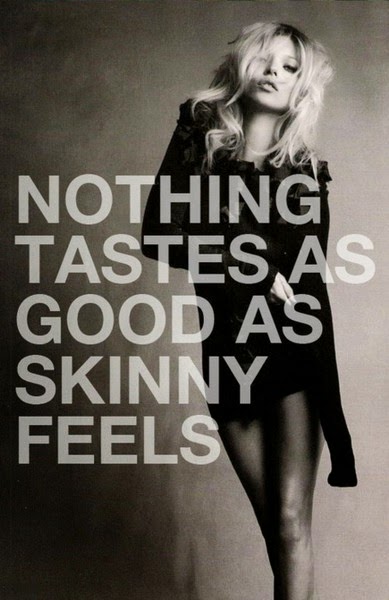Frankie's AS Media Studies
Thursday 13 November 2014
Wednesday 15 October 2014
Ideologies
Ideologies
This quote from Kat Dennings goes against normal ideologies because most people would love to be famous, and they don't care what they are famous for as long as they are. This tells us that due to the portrayal of celebrities and celeb life, people want to be famous, to be like their idols but people that are famous know the work you have to put in.
This magazine with Dave Grohl on the front portrays ideologies such as, people in bands and associated with the rock genre are scary, and menacing. It also plays against certain ideologies though, such as, he has long hair, usually meant for girls. Also, the whole band are in his mouth and very small, portraying that he is the main guy in the band, and the others are inferior.
The poster above, featuring Kate Moss, has a woman standing there in dark colours like grey and black, and quotes "Nothing tastes as good as skinny." This promotes anorexia, and tells girls if they want to be skinny and look like this they should not eat, starve themselves, and it also portrays that it won't hurt them but they will feel good about it, and it will make them look and feel better if they are skinner.
Tuesday 7 October 2014
Friday 3 October 2014
The American Film Industry
The American Film Industry.
Origins of American Film Industry.
The origins and development of the American film industry are from the period 1895-1930.
During this time the emerging industry developed into an important popular medium organised into clearly defined exhibition, production, and distribution elements.
The Studio Era.
The period from 1930 to 1949 in American film industry is known as the studio era.
There were the 'BIG FIVE' /majors.
All of the big five studios are vertically integrated. This is a company is organised so that it oversees a product from the planning/development stage, through production, to marketing, and distribution, through to the consumer.
During the studio era the Big Five owed to production studios, the distribution companies, and most of the cinemas in the US.
Production studios
Distribution
Cinemas
The end of the Studio Era.
In 1949, the major studios were forced t sell off he cinema chins that they owned by the US government, after a court ruling that their practices were monopolistic.
The American film industry declined further in the 1950s due to the rise of television.
It wasn't until the late 1980s that Hollywood studios fully recovered.
The Contemporary American Film Industry.
The American film industry is now dominated by dix major film companies.
The contemporary 'BIG SIX' account for nearly 90% of the North American Film Market.
Al of these companies are SUBSIDIARIES of major MEDIA CONGLOMERATES.
SUBSIDIARIES are companies underneath other companies.
MEDIA CONGLOMERATES are the main companies over the subsidiaries.
The 'BIG SIX' - major studio subsidiaries.
- Warner Bros.. pictures owned by Time Warner
- 20th Century Fox owned by News Corporation
- Paramount Pictures owned by Viacom
- Columbia Pictures/Sony owned by Sony
- Walk Disney/Touchstone Pictures owned by Disney
- Universal Studios owned by General Electric/Vivendi
FUND---FUND
These two companies
fund the movie.
America-------------------- Europe
^^This company ^^This company will
will pay to put it out pay to put it out in
in America. Europe.
Cinema/DVD
This is responsible for putting it
in cinemas and releasing it on
DVD.
Wednesday 1 October 2014
Ideologies and Values.
Ideologies and Values.
Dominant reading - The reading media producers hope the audience will take from the media.
Negotiated reading - Audienes acknoledge the preferred reading, but modify it to suit their own values/opinions.
Oppositional reading - Audience members from outside the target audience reject the preferred reading completely and make their own opinions.
Active audience thory has been critisied harshly in part beause it seems to suggest mporal relaivism. If every meaning is up for neotiaion, there are no absolute truths.
An instituion is any organisation operating in the media.
Ideology is tied to audience.
Ideological dicourse: The views taken on hese subjects from the basis of our social rules and practice:
- Education
- Employment
- Gender
- Sexuality
- Racism
- Feminism
- Nationalism/National Identity
- Youth/Age
- Left Wing/Right Wing Politics
- Environmentalism
- Public/Personal Reality
- Crime and Punishment.
Mis-en-scene.
Mis-en-scene is basically eveything in a scene.
It involves:
Below, is the link to my photoshopped edit of a scene.
This scene involves:
It involves:
- Sets/settings
- Lighting/Colour
- Costume/Make-up
- Props
- Performance
- Positioning of Characters.
Below, is the link to my photoshopped edit of a scene.
This scene involves:
- Setting: A stage, with a crowd.
- Lighting/Colour: It is really dark, but the fire is an orangey red so it stands out.
- Cosumes/Make-up: They are all skeletons.
- Props:here is drums, a microphone and an electric guitar.
- Characters:they are all on the stage performing at a concert.
Tuesday 30 September 2014
Our edited video.
This is our editing video^
The editing techniques we are showing are:
Eyeline match: A type of edit which cuts from one character to what that character has been looking at.
AND
Cross cutting: The editing technique of alternating, interweaving, or interspersing one narrative action (scene, sequence or event) with another - usually in different locations or places, thus combining the two: this usually suggests parallel action. Often used to dramatically build suspense in chase scenes or to compare two different scenes.
Subscribe to:
Posts (Atom)




